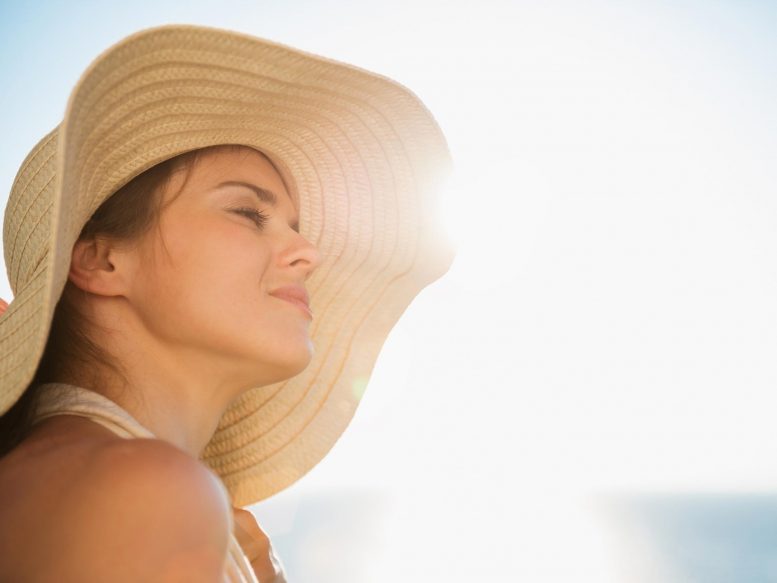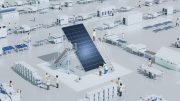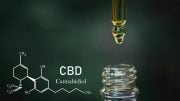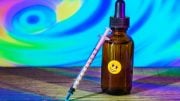
Study shows that risk versus benefit calculations from solar exposure may need to be re-evaluated.
Previously published solar exposure guidelines for optimal vitamin D synthesis based on a study of skin samples may need to be revised, according to new research published today (September 27, 2021) in PNAS.
A study by researchers from King’s College London, with support from the NIHR Guy’s and St Thomas’ Biomedical Research Centre, has tested the optimum ultraviolet radiation (UVR) wavelengths for human skin production of vitamin D in sunlight.
UVR from sunlight can cause sunburn and skin cancer, however, it is the most important source of vitamin D that is essential for healthy bone development and maintenance.
Public health advice on sunlight exposure takes both risk and benefits into account. Calculating the potential risks and benefits from sunlight exposure is not simple because the health outcomes from UVR exposure vary considerably with wavelength within the sun’s UVR spectrum. For example, the sun’s UVR contains less than 5% short wavelength UVB radiation but this is responsible for over 80% of the sunburn response. Each health outcome from solar exposure has its own unique wavelength dependency.
The association between specific UVB wavelengths and vitamin D production was determined more than thirty years ago in skin samples (ex vivo). However, the finding is less well established and there have been doubts about its accuracy. These doubts compromise risk/benefit calculations for optimal solar exposure.
Researchers led by Professor Antony Young from King’s College London measured blood vitamin D levels in 75 healthy young volunteers, before, during, and after partial or full body exposure to five different artificial UVR sources with different amounts of UVB radiation, to weigh the trade-off between the benefits of solar exposure, which include vitamin D synthesis, versus the risks of sunburn and skin cancer.
They then compared their results with those that would be predicted from the old ex vivo vitamin D study and found the previous study is not an accurate predictor of benefit from UVR exposure.
The authors recommend a simple systematic correction of the ex vivo wavelength dependency for vitamin D. The new study means that many risk benefit calculations for solar UVR exposure must be reviewed with a revised version of the wavelength dependency for vitamin D.
Professor Antony Young said: “Our study shows that risk versus benefit calculations from solar exposure may need to be re-evaluated. The results from the study are timely because the global technical committee, Commission internationale de l’éclairage, that sets UVR standards will be able to discuss the findings of this paper to re-evaluate the wavelength dependency of vitamin D. Further research from our group will determine the risk/benefit calculations.”
Reference: “A revised action spectrum for vitamin D synthesis by suberythemal UV radiation exposure in humans in vivo” by Antony R. Young, Kylie A. Morgan, Graham I. Harrison, Karl P. Lawrence, Bibi Petersen, Hans Christian Wulf and Peter A. Philipsen, 27 September 2021, Proceedings of the National Academy of Sciences.
DOI: 10.1073/pnas.2015867118









The obvious question that isn’t answered is, “Are current exposure recommendations to little or too much?”
If you scan the string of “related” articles immediately preceding the ads preceding this response block(lol), you might detect substantial ambivalence and opposition among their titles. In a concerted comparison, one will advance no further in the direction of an answer. This article is no exception. It promises but doesn’t deliver any info which isn’t contained in the title: the proverbial HONEY POT 🍯. Take care and stay in the light. But wear sunglasses and cover yourself. There IS something happening in the Sun… SOMETHING to do with an heretofore unknown form of Solar radiation. My interest in that subject is what brought me here.
✋
What they really say in this article? Waste of time reading it.
“The association between specific UVB wavelengths and vitamin D production was determined more than thirty years ago in skin samples (ex vivo). However, the finding is less well established and there have been doubts about its accuracy. These doubts compromise risk/benefit calculations for optimal solar exposure.”
The absolute state of science
They really need to take altitude into account as well. Not everyone lives at sea level and the higher the altitude, the less atmosphere there is protecting us from the sun’s rays.
The article title and article never promised to give the new calculations. It simply stated the recommendation of further study was needed. LOL we all came here hoping to see the new “revision”. TOO BAD hahahahaha
My Summary
Professor Antony Young wants more money for his studies.
Unfortunately what they don’t address is the negative effect of solar UV radiation at the current levels which are significantly higher than any time in recent history. The important missing point here is that UV over 9 will cause permanent damage to the eyes in 15 minutes if you don’t have the proper eye protection. We now Periodically see UVS as high as 13 the highest level in Europe used to be six or seven and in the United States it was 10 these numbers aren’t relevant anymore it is all changed the UV levels are much higher. A cloudy sky does not protect you from the UVS if you go out in the sun you have to have UV protection glasses on or you will permanently damage your eyes very quickly. I had to point this out because this has been proven to be true through research by professional ophthalmologist and scientists.
“… UV over 9 will cause permanent damage to the eyes in 15 minutes if you don’t have the proper eye protection.”
I presume that is why the Europeans that first explored Australia found that all the Aborigines were blind. They didn’t have proper eye protection! That is why kangaroos evolved to hop. They didn’t need to see where to put their feet as animals do when walking. The great mystery is why the Aborigines didn’t similarly learn to hop.
That’s five minutes that I’ll never get back. I read another article last week that said we may need to take more but it did not say how much more. Much ado and then nothing…
The bogus article ever
This apparently this article is for non melaninated people
I hate how you turned one sentence worth of information into multiple paragraphs. Its standards by which you journalists are trained and evaluated that need to be changed.
Useless article, mainly because I take a daily vitamin D supplement which has cured my mild vitamin D deficiency.
I feel the same way. Though it did not specifically say it was going to provide the up to date correct calculations, it can be assumed the calculations just from the description of the article. Myself, I have read many articles, even ones with 1 word descriptions that had a ton of useful information regarding the description and more. Does anyone think it could have anything to do with Vitamin-D, and it’s relation to Covid?
I also find the lack of additional information disappointing, but coming from opposite the perspective.Kind of. There are several chronic health issues linked to low levels of Vitamin D. If anything, in my little acre people don’t get enough sun exposure. We’ve all got porches and decks but I rarely see anyone out when I’m walking. To be fair, no one wants to spend much time out during the summer with temps in the 90s and humidity at 85 percent.
Here’s my takeaway from this article: screw it, just take a supplement instead.
You also need to take vitamin k levels into account as you need this vitamin to help produce vitamin D in the body.
For a very long time the dermatology branch of healthcare has done significant damage to the public with their scare tactics. Using sunscreen prevents the body from getting the sunlight they need to meet their vitamin D requirement. During the fall and winter months if you live from Atlanta area north it is extremely difficult if not impossible to get the vitamin D necessary from the Sun because of the rays and the angle of them hitting the Earth. Even infants who are breastfed are not getting enough vitamin D daily. People who suffer from obesity need two to three times as much vitamin D intake daily as a person of normal weight. Vitamin D is essential to the immune system and to the health of of women giving birth to Healthy babies. There is so much information that is false about vitamin D and much of it was based on a lack knowledge from almost a century ago.
Many dermatologists nowadays recommend to get your vitamin D through food and/or supplements, anyway, and say to avoid UV exposure as much as possible.
Seriously?! The entire article was a rephrase of the title in each paragraph.. never an actual answer to it! I hate writing like this..
Article wasted my time. I kept reading and waiting for something that would benefit me. Very disappointed.
What a waste of time article!
Wow, what a waste of time! We absolutely need sunshine! Get outdoors! And try finding news in alternative places that may actually make an effort to get you some truth! Not here. A lil ashamed they pulled me in..
Wow this article does not say if we need more or less sun exposure, the answer is already available. Most people are deficient in vitamin D and clearly need more. The science shows that higher levels of vitamin D lower the risk of all cancers buy an average of 50%, except skin cancer. Of course, skin cancer is the easiest cancer overcomes it has a 95% recovery rate. Normally you just cut it out, no radiation or chemo needed. On the other hand, prostate, breast,, cancer etc. have a very high death rate, with all sorts of horrible chemo, radiation and surgeries needed. In general, we need much more sun and vitamin D intake, just don’t burn.
Simple. Ten minutes a day,(no glasses) of real light on 50% exposed skin is what you need not just for Vitamin D but for melatonin.
Never bought into the whole sunscreen everyday nonsense. I iuse if exposure is for more than 20-30 minutes or in water.
After experiencing crushing vertigo and other health issues, I finally went to my health provider with tears in my eyes explaining that I felt like I was dying. That I wasn’t suicidal, but that I felt like I was dying. She calmly started asking a list of symptoms, and at the end explained my vit d levels were at a 14, and all my symptoms were commented with a vitamin d deficiency
Long ray effects, late afternoon are beneficial, + less likely to damage the skin. I am a licensed esthetician, in skin are for many years.
Let me guess sunlight is bad everybody needs the shot?get lost.
Really? Going to say how the sun can cause cancer but don’t say nothing about all the cooking oils that cause skin cancer and blame it on the sun🤔
Well done comment section!
What a bunch of BS. Vit D is vital to your health. Get specific Vit D levels blood work done to make sure you’re getting enough.
I usually get 20 min midday sun during Jun-Sep months, but since I’m near NY I don’t get beneficial wavelengths for most of the year. Been using a vitamin D app to let me know what time solar noon is. I also supplement with a couple drops of vitamin D + K2 daily, year round. Thinking about getting a red light therapy lamp as well. Always wear eye protection, hat, and high SPF cover up (no toxic sun screens). I think I just provided 10x the value of this article.
I also read the article with interest hoping to find information on how much vitamin D is recommended. This article said nothing definitive. I need to take supplements as I am older. What a waste of my time. A lot of nothing was said using a lot of words.
I’m getting so sick and tired of all the idiots who think they are some highly trained scientist that knows everything Does everyone have to think they are the smartest the best whatever. If you don’t start listening to scientists then shut up. I’m not the brightest person in world, but even I can see the sun is getting more deadly. Shut your mouths and listen instead of trying to be a know it all.
Absolutely wasted my time reading this. You answered nothing of any importance! What’s the real study? To see who will continue to read something that says nothing at all?
Actually, Aboriginal people in outback Australia have vision that can be more than four times better than non-Indigenous people. The prevalence of vision problems in Indigenous people is a result of cataracts, diabetic eye disease and a disease non-Indigenous children don’t get – trachoma. This is not an issue of sun exposure.
The idea that the sun is bad for you is like the idea that animal fat and meat is bad for you.. Two lies that lead to sub-optimal human health.
So am I suppose to get less or more Sun exposure?
Tell us what we need to know
Padma Srinath
This article provided very little if any new information.